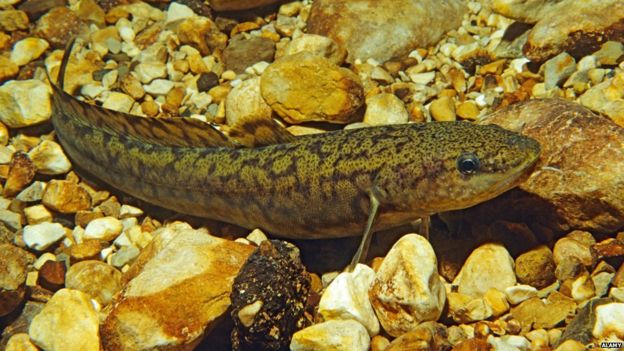When it comes to animals threatened with extinction, the cute and cuddly ones tend to get the most attention. But what about the ugly ones that go unnoticed when their numbers start to dwindle? Mary Colwell speaks up for the burbot.

"When you are furry, when you're lovable, you often fare better in people's interests than if you're bald and rather ugly," says Richard Sabin, curator of mammals at the Natural History Museum in London, referring to the popular appeal of animals such as pandas.
It was never going to bode well for the burbot then. The fish is "fat looking and a little bit flabby and soft" - a description offered by the museum's fish curator, James Maclaine.
He isn't the only one who doesn't swoon at its looks. "People have mixed feelings about the burbot," he says. "There's a 19th Century account by a man called Pennant who calls it 'a very delicate fish for the table, though of disgusting appearance when alive'."
It is true that burbot are… characterful. They are long and sinuous, commonly growing to more than a metre in length, but can get much larger. They look very much like eels - they are often called eelpout - and when caught, will wrap themselves around the angler's arms and legs.

With large squashed heads, small eyes, downturned mouths full of razor sharp teeth and tubes protruding from their nostrils, they are not exactly pretty. They are also exceedingly slimy and under the chin is a single long, fleshy feeler called a barbel, giving the impression of a goatee beard.
These characteristics are important. They are all adaptations to the cold, dark world at the bottom of northern lakes and rivers.
These were ice-age fish that once swam unhindered in a glacial world, until the ice retreated 10,000 years ago leaving some remnant populations throughout the northern hemisphere, including eastern England.
Find out more
Ten facts about the barbot
- Natural Histories is a series about our relationships with the natural world
- Listen to Barbot on BBC Radio 4 on Tuesday 7 July at 11:00 BST or online after broadcast
The burbot is the only member of the cod family that lives in fresh water. For several months a year burbot can be trapped under ice - they need cold temperatures to spawn but all that slime and flabbiness provide excellent protection.
Their teeth are essential for catching a huge variety of food. "They're a very voracious predator," says Steve Simpson, marine biologist and lover of burbot at Exeter University. "There are reports of them eating birds, eating snakes, eating frogs - they really will eat anything they encounter."
Because their world is dark, they don't need big eyes. They use their barbels to detect vibrations and catch their prey. They may not be beautiful but they are perfectly adapted to their gloomy, chilly world.
Although still present throughout the rest of Europe and North America, the only burbot in England today can be found in the vaults of the Natural History Museum in London, preserved in pickling jars. Once a proud member of Britain's piscatorial family, the fish disappeared from British waters in the 1960s - the Angling Times offered a reward of £100 to anyone who found one in the UK, but that money lies unclaimed.
(BBC News/ Magazine)

